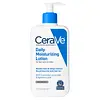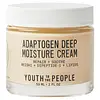CeraVe Daily Moisturizing Lotion Normal To Dry Skin Versus Youth To The People Adaptogen Deep Moisture Cream
What's inside
What's inside
 Key Ingredients
Key Ingredients

 Benefits
Benefits

 Concerns
Concerns

 Ingredients Side-by-side
Ingredients Side-by-side

Water
Skin ConditioningGlycerin
HumectantCaprylic/Capric Triglyceride
MaskingCetearyl Alcohol
EmollientCetyl Alcohol
EmollientPotassium Phosphate
BufferingCeramide NP
Skin ConditioningCeramide AP
Skin ConditioningCeramide EOP
Skin ConditioningCarbomer
Emulsion StabilisingDimethicone
EmollientCeteareth-20
CleansingBehentrimonium Methosulfate
Methylparaben
PreservativeSodium Lauroyl Lactylate
EmulsifyingCholesterol
EmollientDisodium EDTA
Dipotassium Phosphate
BufferingPropylparaben
PreservativeHydrolyzed Hyaluronic Acid
HumectantPhytosphingosine
Skin ConditioningXanthan Gum
EmulsifyingPolysorbate 20
EmulsifyingPolyglyceryl-3 Diisostearate
EmulsifyingWater, Glycerin, Caprylic/Capric Triglyceride, Cetearyl Alcohol, Cetyl Alcohol, Potassium Phosphate, Ceramide NP, Ceramide AP, Ceramide EOP, Carbomer, Dimethicone, Ceteareth-20, Behentrimonium Methosulfate, Methylparaben, Sodium Lauroyl Lactylate, Cholesterol, Disodium EDTA, Dipotassium Phosphate, Propylparaben, Hydrolyzed Hyaluronic Acid, Phytosphingosine, Xanthan Gum, Polysorbate 20, Polyglyceryl-3 Diisostearate
Water
Skin ConditioningGlycerin
HumectantEthyl Oleate
EmollientCentaurea Cyanus Flower Water
Skin ConditioningNiacinamide
SmoothingGlyceryl Stearate Citrate
EmollientBehenyl Alcohol
EmollientLauryl Laurate
Skin ConditioningButyrospermum Parkii Butter
Skin ConditioningAmmonium Polyacryloyldimethyl Taurate
Emulsion StabilisingInonotus Obliquus Extract
Skin ConditioningTremella Fuciformis Polysaccharide
Emulsion StabilisingAcetyl Dipeptide-1 Cetyl Ester
Skin ConditioningGanoderma Lucidum Extract
Skin ProtectingLinoleic Acid
CleansingLinolenic Acid
CleansingOleic Acid
EmollientPhytic Acid
Sodium Hydroxide
BufferingStearic Acid
CleansingWithania Somnifera Root Extract
Skin ConditioningPanthenol
Skin ConditioningTocopherol
AntioxidantCeramide NP
Skin ConditioningC12-16 Alcohols
EmollientHydrogenated Lecithin
EmulsifyingPalmitic Acid
EmollientSimmondsia Chinensis Seed Oil
EmollientSqualane
EmollientArginine
MaskingCaprylyl Glycol
EmollientCitric Acid
BufferingCoco-Betaine
CleansingEthylhexylglycerin
Skin ConditioningFructose
HumectantHelianthus Annuus Seed Oil
EmollientPropanediol
SolventXanthan Gum
EmulsifyingCaramel
Cosmetic ColorantBenzyl Alcohol
PerfumingPhenoxyethanol
PreservativePotassium Sorbate
PreservativeWater, Glycerin, Ethyl Oleate, Centaurea Cyanus Flower Water, Niacinamide, Glyceryl Stearate Citrate, Behenyl Alcohol, Lauryl Laurate, Butyrospermum Parkii Butter, Ammonium Polyacryloyldimethyl Taurate, Inonotus Obliquus Extract, Tremella Fuciformis Polysaccharide, Acetyl Dipeptide-1 Cetyl Ester, Ganoderma Lucidum Extract, Linoleic Acid, Linolenic Acid, Oleic Acid, Phytic Acid, Sodium Hydroxide, Stearic Acid, Withania Somnifera Root Extract, Panthenol, Tocopherol, Ceramide NP, C12-16 Alcohols, Hydrogenated Lecithin, Palmitic Acid, Simmondsia Chinensis Seed Oil, Squalane, Arginine, Caprylyl Glycol, Citric Acid, Coco-Betaine, Ethylhexylglycerin, Fructose, Helianthus Annuus Seed Oil, Propanediol, Xanthan Gum, Caramel, Benzyl Alcohol, Phenoxyethanol, Potassium Sorbate
 Reviews
Reviews

Ingredients Explained
These ingredients are found in both products.
Ingredients higher up in an ingredient list are typically present in a larger amount.
Ceramide NP is a type of ceramide and formally known as ceramide 3.
Ceramides are intercellular lipids naturally found in our skin that bonds dead skin cells together to create a barrier. They are known for their ability to hold water and thus are a great ingredient for dry skin.
Ceramides are an important building block for our skin barrier. A stronger barrier helps the skin look more firm and hydrated. By bolstering the skin ceramides act as a barrier against irritating ingredients. This can help with inflammation as well.
If you would like to eat ceramides, sweet potatoes contain a small amount.
Read more about other common types of ceramides here:
Ceramide AP
Ceramide EOP
Glycerin is already naturally found in your skin. It helps moisturize and protect your skin.
A study from 2016 found glycerin to be more effective as a humectant than AHAs and hyaluronic acid.
As a humectant, it helps the skin stay hydrated by pulling moisture to your skin. The low molecular weight of glycerin allows it to pull moisture into the deeper layers of your skin.
Hydrated skin improves your skin barrier; Your skin barrier helps protect against irritants and bacteria.
Glycerin has also been found to have antimicrobial and antiviral properties. Due to these properties, glycerin is often used in wound and burn treatments.
In cosmetics, glycerin is usually derived from plants such as soybean or palm. However, it can also be sourced from animals, such as tallow or animal fat.
This ingredient is organic, colorless, odorless, and non-toxic.
Glycerin is the name for this ingredient in American English. British English uses Glycerol/Glycerine.
Learn more about GlycerinWater. It's the most common cosmetic ingredient of all. You'll usually see it at the top of ingredient lists, meaning that it makes up the largest part of the product.
So why is it so popular? Water most often acts as a solvent - this means that it helps dissolve other ingredients into the formulation.
You'll also recognize water as that liquid we all need to stay alive. If you see this, drink a glass of water. Stay hydrated!
Learn more about WaterXanthan gum is used as a stabilizer and thickener within cosmetic products. It helps give products a sticky, thick feeling - preventing them from being too runny.
On the technical side of things, xanthan gum is a polysaccharide - a combination consisting of multiple sugar molecules bonded together.
Xanthan gum is a pretty common and great ingredient. It is a natural, non-toxic, non-irritating ingredient that is also commonly used in food products.
Learn more about Xanthan Gum